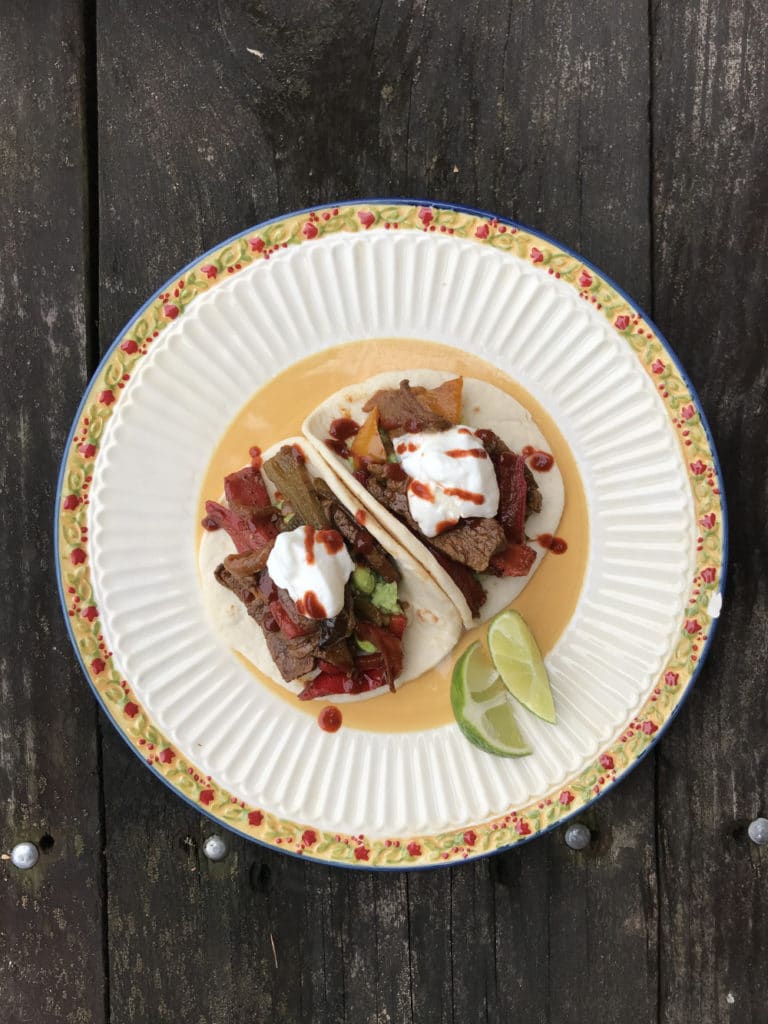Week #18; Purple + sun
- On: September 16, 2020
 0
0
Beth’s dad
Folks, my father is very ill. It is age-related, not COVID-19. Steve and I plan to visit him in a few days, our first visit since the pandemic began. Our crew will keep everything running well. They know what to do. However, I ask for a little more patience than usual this week and next. Expect less precise box lists. I take care of getting all the details right but I don’t want to burden our crew with that work. They will prep nice boxes for you. Also, I can’t handle any special requests. Thank you.
Beth.
After the rain
You too shivered through last week’s unusually cold weather. We farmers prefer average conditions. We held our breath during last week’s cold, rainy days. About half our winter squash crop was still in the field, and weather like that can be deadly for winter squash. We waited a few days to let everything dry, then brought in the crop. They looked very good at harvest, and we are hopeful that they escaped lasting damage. We’ll know in a week or so.
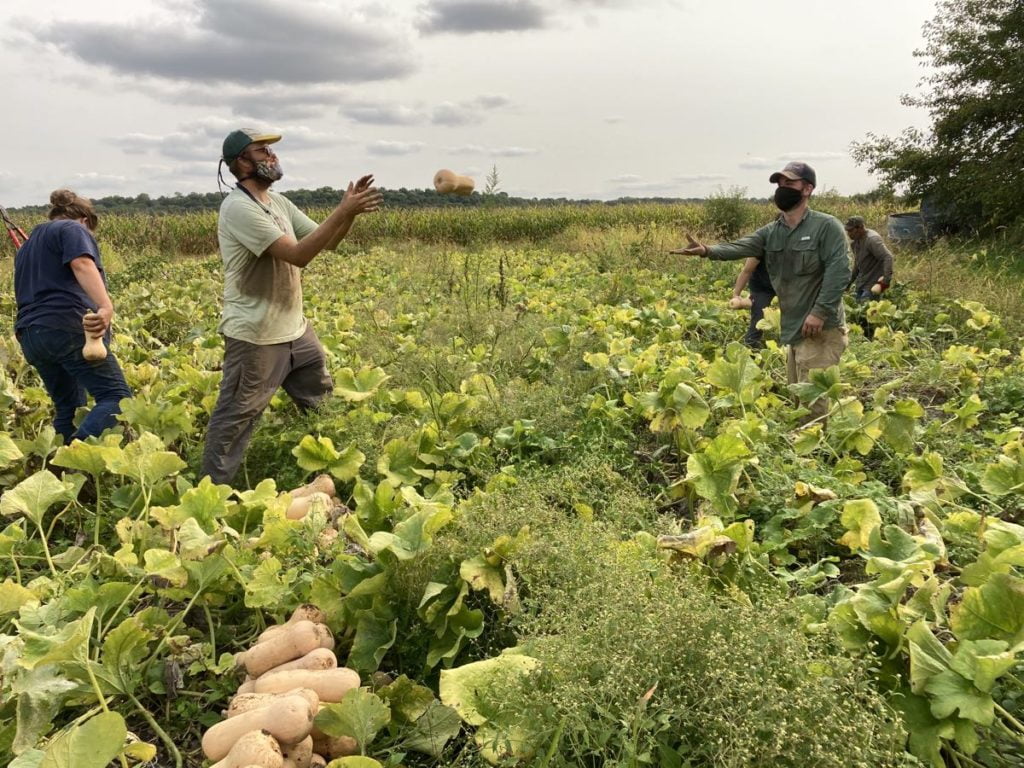
From left, Kristin, John, Karen (in back), Chris, and Raul.
Like most farm jobs, this is a team effort. Karen, Kristin, Raul and I have judged and cut squash together for years. Chris and John tossed and piled the squash to make it easy to collect. John was the receiver for almost every squash. He was mortified and apologetic after dropping one squash. One. That’s an amazing record.
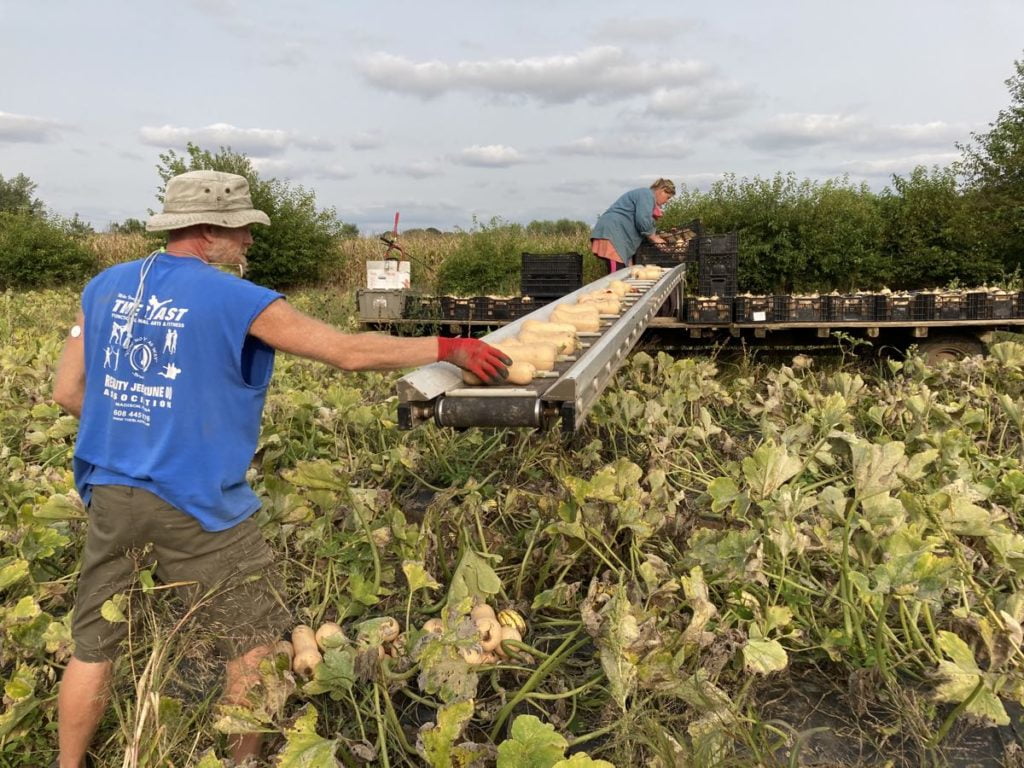
From left, Ben and Maggie.
Squash is heavy. Let’s use the harvest belt.
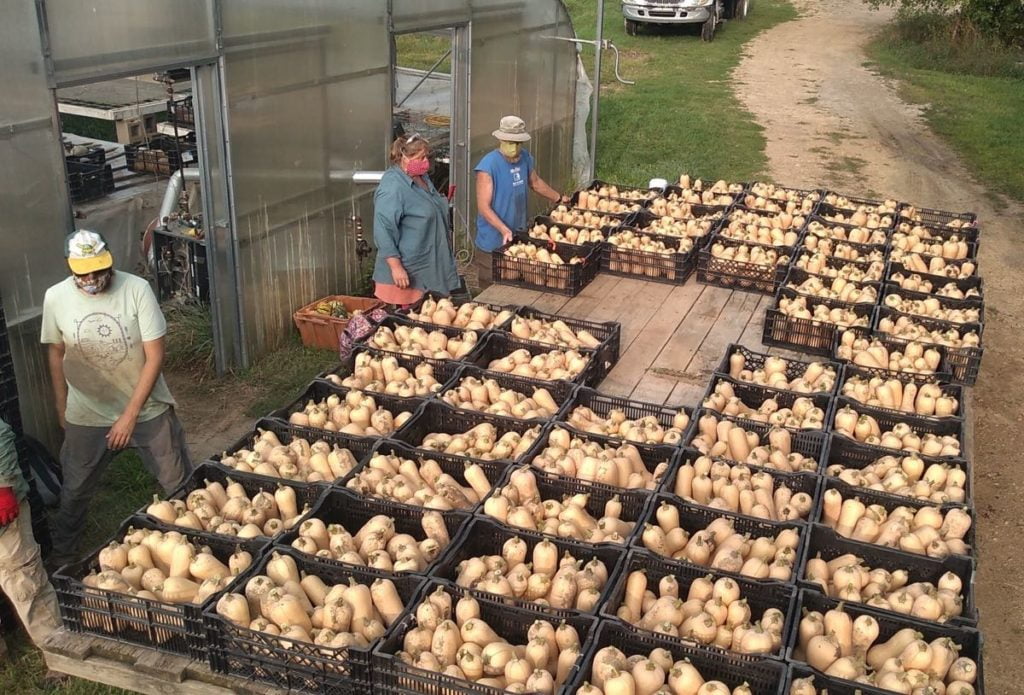
Our wagonload of squash. That’s a nice butternut harvest. Now you understand why dropping only one squash was remarkable. Photo credit Billy Frain.
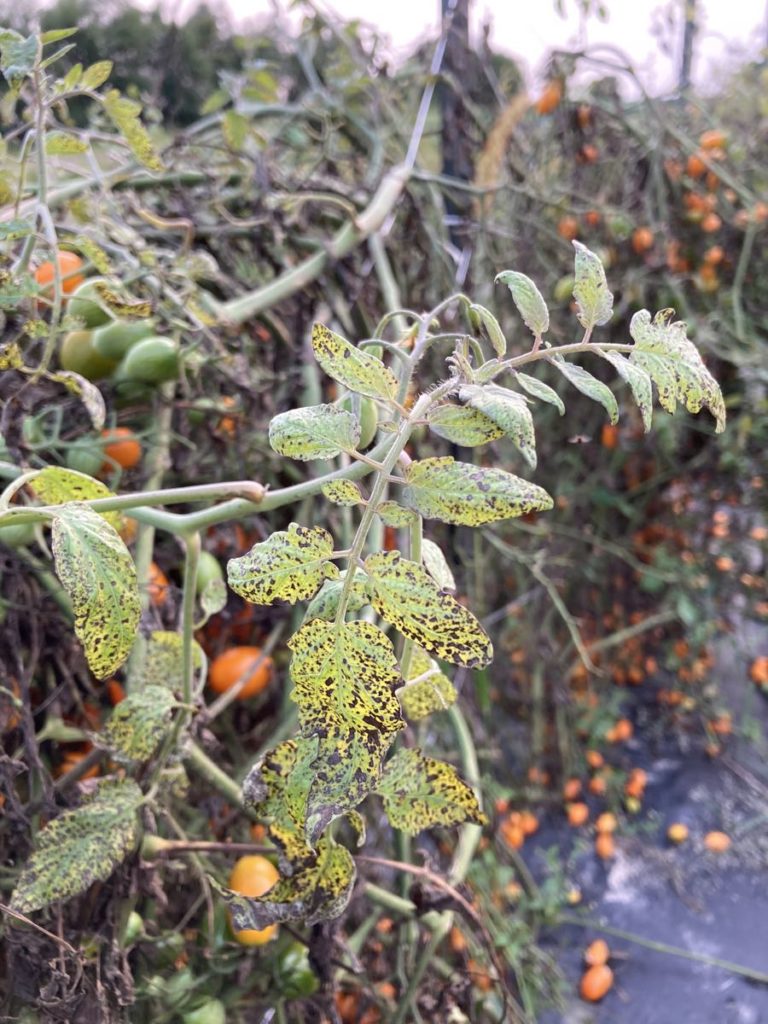
The cold, wet weather ended our tomato crop. Leaves this diseased cannot support ripening fruit.
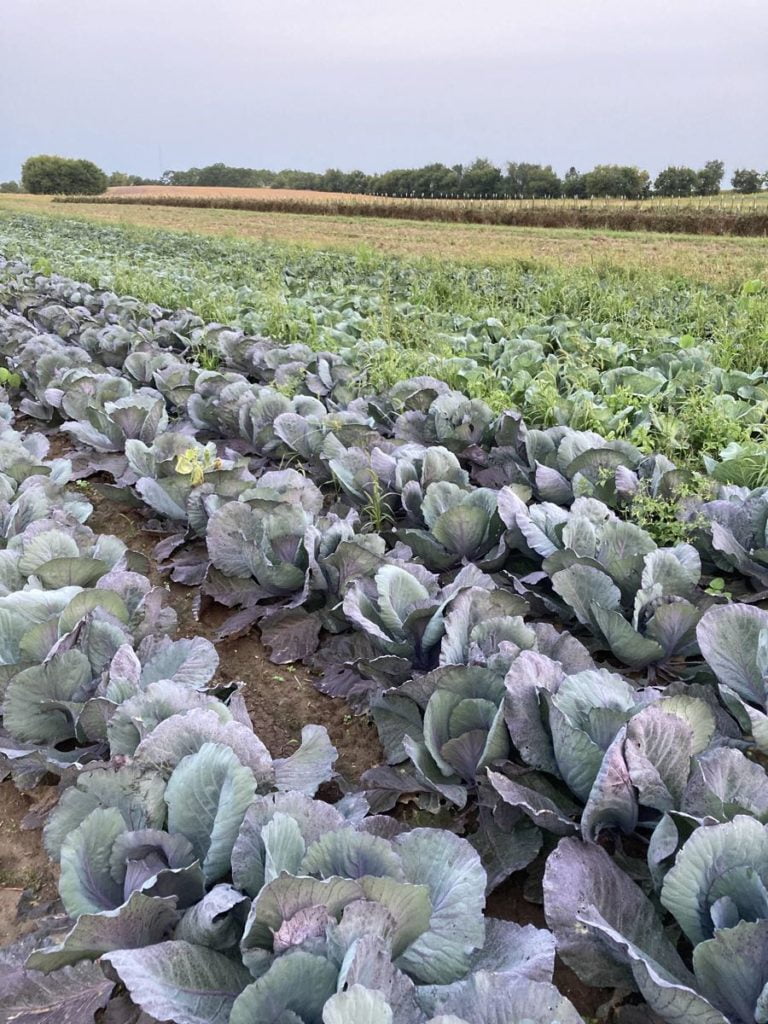
On the other hand, all our brassica (cabbage family) crops loved the cool nights. Above, the cabbage is growing well. In contrast, you can see the dying line of trellised tomato plants in the distance.
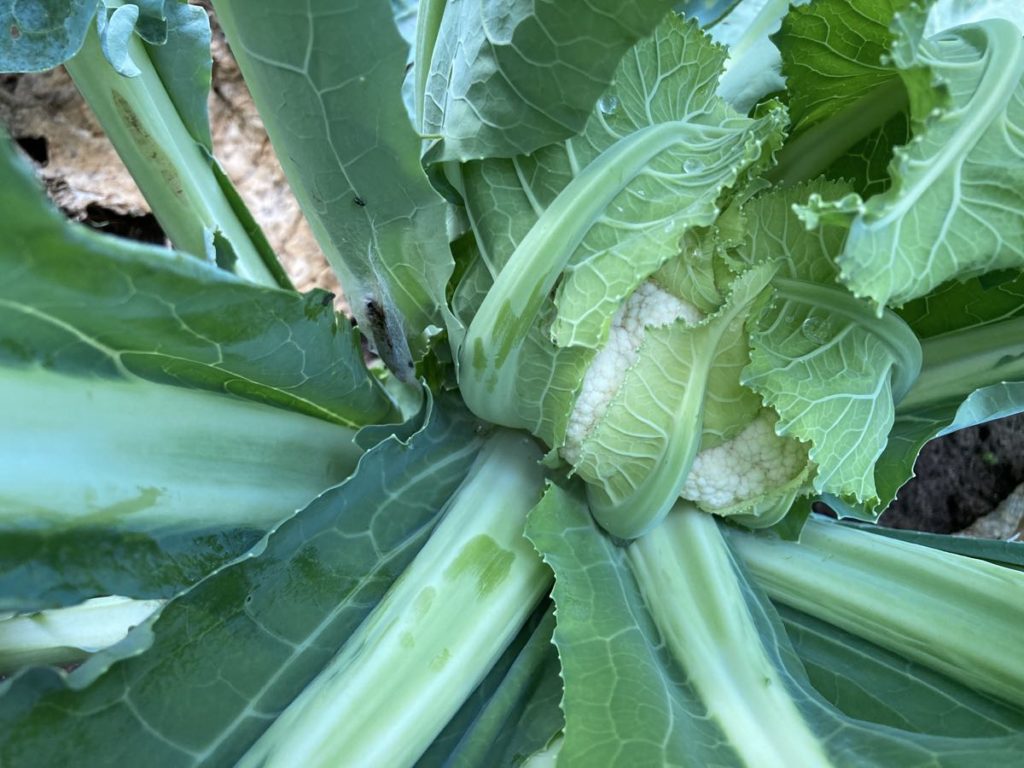
The first cauliflower is forming, and should be ready in a few weeks.
Veggie List & Veggie Notes
Week #18, September 17/18, 2020
– Weekly shares
– EOW/ purple
– Sampler/ sun
Everyone gets most items from this list:
Winter squash, 1
Bok choy
Kale
Romano beans, 0.6 lb
Roulette chile (NOT HOT, in bag with Romano beans)
Jalapeno chile (HOT, loose in the box)
Red peppers, 1 or 2, bell or frying
A small bag of tomatoes (grape OR plum)
Yellow onion
Red onion
Basil
Next week’s box will probably contain cabbage, butternut squash and more.
Acorn squash – See below for cultivar photo. All types are cured and ready to eat. Plan to eat within two weeks.
Bok choy (large rosette with thick white stems and green leaves) – This Asian green is good for stir-frying or sautéing or in soup. You can think of the stems and leaves as two separate vegetables. The stems require longer cooking. The leaves will cook almost as quickly as spinach. Bok choy stores well, so feel free to pull off leaves as you need them, or use the whole head at once. Refrigerate in a plastic bag or other container.
‘Roulette’ chiles – This chile has been bred to have the aromatic taste of habanero chiles, with almost no heat. Snack on them to enjoy their flavor, or add them to any dish. To reduce all chances of spiciness, remove the seeds and midveins. We’ve packed your Roulette(s) in the bag with the beans, so you can recognize it.
Tomatoes – These are the last tomatoes of the season. Eat these soon; they will not store well.
Yellow and red onions – Both are pungent onions, good for frying.
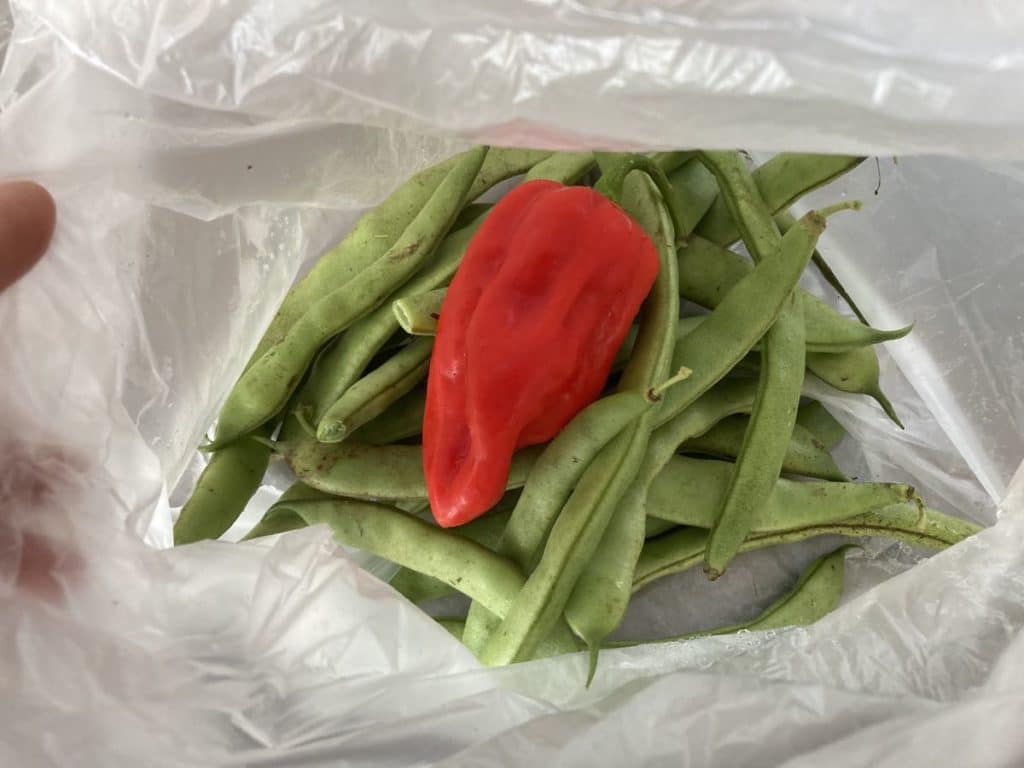
Look for your Roulette chile(s) in your bag of beans.
Winter Squash Primer
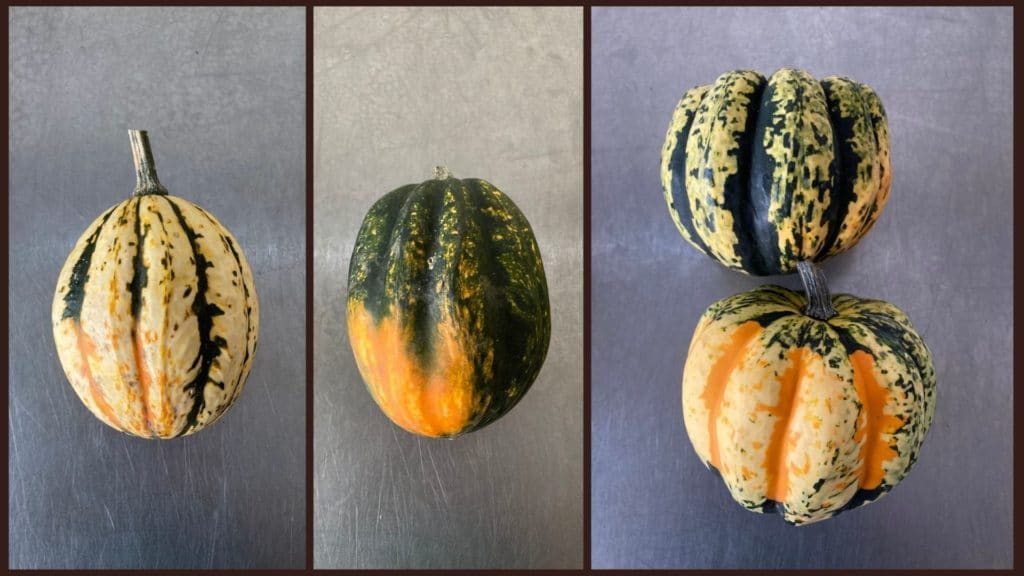
THIS WEEK’S ACORN SQUASH, from left: ‘Jester’ OR ‘Starry Night’ OR ‘Carnival’
Everyone gets one squash this week, of one of the varieties above. We used to grow dark green acorn squash but switched to the newer striped varieties because they taste better, the plants are more vigorous, and the squash are so pretty. Most of the Carnival squash are darker green than usual this year, less colorful than the bottom sample in the Carnival photo. That’s what happens when the plants pollinate during hot weather.
We expect to have a steady supply of squash or sweet potatoes over the coming weeks. Let’s review some basics about winter squash.
Expected life: Some winter squash varieties are ready to eat soon after harvest, others store deep into winter. This week’s acorns are cured and ready to eat. Plan to eat these early varieties within two weeks of delivery. Check the newsletter each week for storage information about that week’s delivery.
Storage: Winter squash store best at room temperature with good air circulation. No cooler than 50 degrees. On your kitchen counter works. Do not cover.
To make squash easier to cut: Microwave on high for 30 to 60 seconds, depending on size of the squash. This will soften the rind and flesh, making it much easier to cut.
Beth’s favorite simple preparation (acorn or butternut): Winter squash are easily roasted in a 400F oven. The goal is to get brown, caramelized edges.
– Split in half with a sharp knife.
– Scoop out and discard seeds.
– Run the squash briefly under running water, then shake off the excess water. Place cavity-side-down on an oiled baking sheet. The little bit of moisture seals the squash to your roasting pan. The water soon evaporates, allowing the squash to brown and caramelize. Caramelization really boosts the flavor.
– Roast at 400F until easily pierced with a fork, 30 – 45 minutes depending on size. Flip over while hot. Add a little butter to melt and some seasoned salt. Cut into wedges and eat.
Stuffed squash
Acorn squash have a central cavity perfect for stuffing. Prepare your favorite fully-cooked stuffing, e.g. a rice or quinoa mixture. Roast your squash as described below. Preheat the stuffing. Fill the cooked squash with stuffing, top with grated cheese and return to the oven until everything is hot.
Can you eat the rind? In my opinion, rinds on these acorn squash are too tough to eat. Steve eats the Jester rind. I don’t.
RECIPES
Visit our 2020 Recipe Log or our 2019 Recipe Log or join our Facebook discussion group.
LOCAL THYME/ Cooking 101
Maple Squash Puree
Chicken and Bok Choy Fried Rice with Sesame Oil
Bok Choy and Pepper Salad with Ramen Noodles
LOCAL THYME/ Cooking 202
Acorn Squash and Beef Chili
Bok Choy Cashew Stir Fry
Quinoa Salad with Beans, Tomato, Sweet Pepper and Feta
LOCAL THYME/ Quick & Easy Meal
Chili-Glazed Salmon with Bok Choy
RECIPES FROM LAUREN
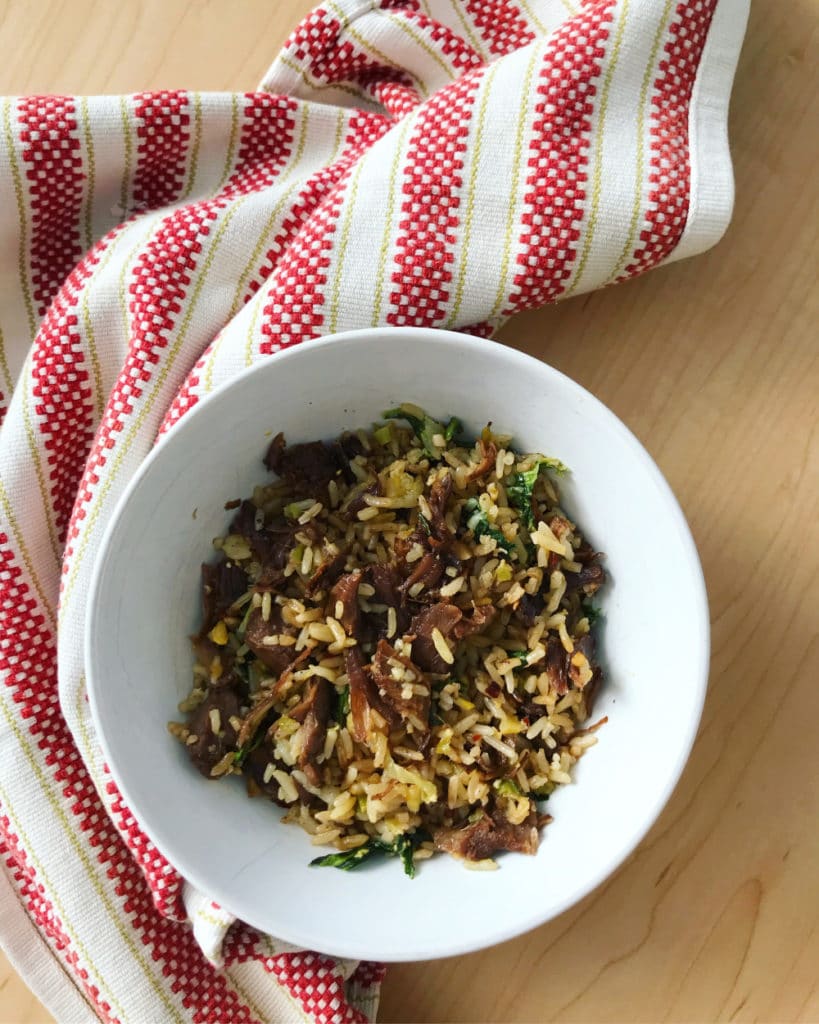
SLOW COOKER BEEF & BOK CHOY FRIED RICE
Serves 4-6
Takes 30 minutes of active cooking time + time for slow cooker to do it’s thing (7-8 hours on low heat; 3-4 hours on high heat)
3-5 pounds beef short ribs or beef neck bones
1/2 cup soy sauce
1/2 cup beef broth
1/4 cup brown sugar
2 tablespoons toasted sesame oil, divided
1 tablespoon freshly grated ginger
2 teaspoons crushed red pepper flakes, divided
1 tablespoon sesame oil
1 large bok choy
5 garlic cloves, minced
1-2 routette chilis, minced
1-1/2 teaspoon Kosher salt, divided
3 cups cooked white rice
3-4 tablespoons vegetable oil
3 eggs
1 red onion, diced
1. Place beef short ribs or neck bones in a crock pot.
2. In a small bowl, whisk together soy sauce, beef broth, brown sugar, 1 tablespoon toasted sesame oil, grated ginger, and 1 teaspoon red pepper flakes until combined. Pour over beef short ribs or neck bones. Let cook for 3-4 hours on high heat or 7-8 hours on low heat. Once cooked through and very tender, shred meet from bone and place in large bowl. Reserve 1/2 cup of the delicious juices for later use.
3. When you are ready to start your meal, use a knife to separate the bok choy leaves from your stems. Roughly chop the greens and set them to the side. Thinly slice the stems.
4. In a large skillet (preferably cast-iron or other non-stick surface), warm remaining tablespoon sesame oil over medium heat. Add bok choy stems, garlic, roulette pepper, and 1/2 teaspoon salt to pan and saute gently for 5-10 minutes until garlic is fragrant and stems are well-softened. Place in bowl with shredded beef.
5. Add two tablespoons and 1/2 teaspoon red pepper flakes to same pan. No need to wipe it out. Let it heat for a couple minutes then add about half of the rice followed by 1/2 teaspoon salt. It should sputter and splatter a little bit. Let it cook for a couple minutes. You want the bottom of the rice to crisp. Saute generally (scraping rice so it doesn’t stick to the bottom as necessary) for an additional 5 minutes until all the rice is coated in oil and a little golden. Add to bowl with beef and cooked bok choy stems.
6. Add another tablespoon of oil and remaining 1/2 teaspoon red pepper flakes followed by remaining rice and salt. Cook this second batch of rice just like you did with the first one. Add to bowl when crisped.
7. Reduce skillet to medium low heat and add last tablespoon vegetable oil if the pan is dry (it likely won’t be).
8. In a small bowl, whisk eggs together and then add bok choy greens. Add to skillet and cook for 5-10 minutes turning occasionally with a spatula until softly scrambled.
9. Add eggs to bowl of rice along with the diced red onion. Stir to combine all ingredients. Taste and add beef juices as desired for more flavor. Serve warm.
.
????
FALL FAJITAS WITH AVOCADO MASH
Takes 30 minutes
Serves 4-6
1/4 cup olive oil, divided
2 colored peppers, seeded and cut into thin strips
1 yellow onion, cut in half and thinly sliced
3 garlic cloves, minced
1 teaspoon Kosher salt, divided
1/2 teaspoon freshly ground black pepper
1 pound flank steak, cut into thin strips
2 teaspoons cumin
2 teaspoon chili powder
1 pinch cayenne powder
2 avocados
1 lime, juiced
Tortillas
Halved cherry tomatoes, optional
Sour cream or Greek yogurt, optional
Hot sauce, optional
1. In a large heavy skillet, heat 2 tablespoons olive oil over medium heat. Add peppers, onions, and garlic with 1/2 teaspoon each salt and pepper. Cook for 15 minutes, stirring occasionally. You want the veggies to be softened and just beginning to char in places. Add steak along with cumin, chili powder, and cayenne. Saute 5 minutes longer, just until steak is cooked through.
2. Put avocado into a small bowl. Mash gently then add the juice from half a lime and remaining 1/2 teaspoon salt. Taste and adjust flavors as desired. I used the juice from a whole lime but you may not want to.
3. Warm tortillas on a skillet or in microwave and serve with a generous portion of both avocado mash and fajita mixture. Top with sour cream or Greek yogurt, cherry tomatoes and hot sauce if desired. Enjoy!
.

